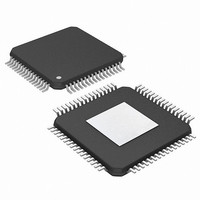PIC24FJ256DA210T-I/BG Microchip Technology, PIC24FJ256DA210T-I/BG Datasheet - Page 81

PIC24FJ256DA210T-I/BG
Manufacturer Part Number
PIC24FJ256DA210T-I/BG
Description
16-bit, 256KB Flash, 96K RAM, USB, Graphics 121 XBGA 10x10x1.20mm T/R
Manufacturer
Microchip Technology
Series
PIC® 24Fr
Specifications of PIC24FJ256DA210T-I/BG
Core Processor
PIC
Core Size
16-Bit
Speed
32MHz
Connectivity
I²C, IrDA, SPI, UART/USART, USB OTG
Peripherals
Brown-out Detect/Reset, GFX, LVD, POR, PWM, WDT
Number Of I /o
84
Program Memory Size
256KB (85.5K x 24)
Program Memory Type
FLASH
Ram Size
96K x 8
Voltage - Supply (vcc/vdd)
2.2 V ~ 3.6 V
Data Converters
A/D 24x10b
Oscillator Type
Internal
Operating Temperature
-40°C ~ 85°C
Package / Case
121-TFBGA
Lead Free Status / RoHS Status
Lead free / RoHS Compliant
Eeprom Size
-
Lead Free Status / RoHS Status
Lead free / RoHS Compliant
Available stocks
Company
Part Number
Manufacturer
Quantity
Price
Company:
Part Number:
PIC24FJ256DA210T-I/BG
Manufacturer:
Microchip Technology
Quantity:
10 000
- Current page: 81 of 408
- Download datasheet (4Mb)
5.0
The PIC24FJ256DA210 family of devices contains
internal Flash program memory for storing and execut-
ing application code. The program memory is readable,
writable and erasable. The Flash can be programmed
in four ways:
• In-Circuit Serial Programming™ (ICSP™)
• Run-Time Self-Programming (RTSP)
• JTAG
• Enhanced In-Circuit Serial Programming
ICSP allows a PIC24FJ256DA210 family device to be
serially programmed while in the end application circuit.
This is simply done with two lines for the programming
clock and programming data (named PGECx and
PGEDx, respectively), and three other lines for power
(V
allows
unprogrammed devices and then program the
FIGURE 5-1:
2010 Microchip Technology Inc.
Note:
(Enhanced ICSP)
DD
), ground (V
customers
FLASH PROGRAM MEMORY
This data sheet summarizes the features
of this group of PIC24F devices. It is not
intended to be a comprehensive reference
source. For more information, refer to the
“PIC24F
Section
(DS39715). The information in this data
sheet supersedes the information in the
FRM.
User/Configuration
Space Select
SS
) and Master Clear (MCLR). This
to
Family
ADDRESSING FOR TABLE REGISTERS
4.
manufacture
Using
Program
Counter
Using
Table
Instruction
“Program
Reference
1/0
0
boards
Memory”
Manual”,
TBLPAG Reg
PIC24FJ256DA210 FAMILY
8 Bits
with
Program Counter
24-Bit EA
24 Bits
microcontroller just before shipping the product. This
also allows the most recent firmware or a custom
firmware to be programmed.
RTSP is accomplished using TBLRD (table read) and
TBLWT (table write) instructions. With RTSP, the user
may write program memory data in blocks of 64 instruc-
tions (192 bytes) at a time and erase program memory
in blocks of 512 instructions (1536 bytes) at a time.
5.1
Regardless of the method used, all programming of
Flash memory is done with the table read and write
instructions. These allow direct read and write access to
the program memory space from the data memory while
the device is in normal operating mode. The 24-bit target
address in the program memory is formed using the
TBLPAG<7:0> bits and the Effective Address (EA) from
a W register, specified in the table instruction, as shown
in Figure 5-1.
The TBLRDL and the TBLWTL instructions are used to
read or write to bits<15:0> of program memory.
TBLRDL and TBLWTL can access program memory in
both Word and Byte modes.
The TBLRDH and TBLWTH instructions are used to read
or write to bits<23:16> of program memory. TBLRDH
and TBLWTH can also access program memory in Word
or Byte mode.
Working Reg EA
16 Bits
Table Instructions and Flash
Programming
0
Byte
Select
DS39969B-page 81
Related parts for PIC24FJ256DA210T-I/BG
Image
Part Number
Description
Manufacturer
Datasheet
Request
R

Part Number:
Description:
Manufacturer:
Microchip Technology Inc.
Datasheet:

Part Number:
Description:
Manufacturer:
Microchip Technology Inc.
Datasheet:

Part Number:
Description:
Manufacturer:
Microchip Technology Inc.
Datasheet:

Part Number:
Description:
Manufacturer:
Microchip Technology Inc.
Datasheet:

Part Number:
Description:
Manufacturer:
Microchip Technology Inc.
Datasheet:

Part Number:
Description:
Manufacturer:
Microchip Technology Inc.
Datasheet:

Part Number:
Description:
Manufacturer:
Microchip Technology Inc.
Datasheet:

Part Number:
Description:
Manufacturer:
Microchip Technology Inc.
Datasheet:











